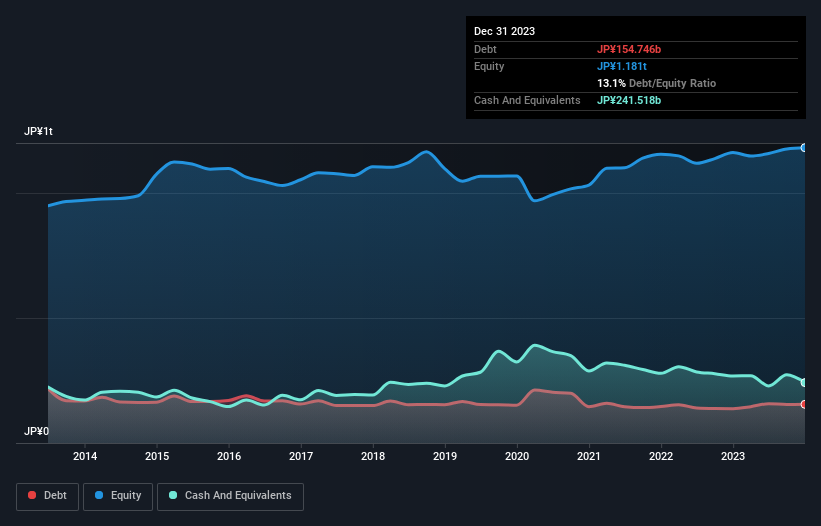Legendary fund manager Li Lu (who Charlie Munger backed) once said, 'The biggest investment risk is not the volatility of prices, but whether you will suffer a permanent loss of capital.' So it seems the smart money knows that debt - which is usually involved in bankruptcies - is a very important factor, when you assess how risky a company is. Importantly, Dai Nippon Printing Co., Ltd. (TSE:7912) does carry debt. But the more important question is: how much risk is that debt creating?
What Risk Does Debt Bring?
Debt is a tool to help businesses grow, but if a business is incapable of paying off its lenders, then it exists at their mercy. If things get really bad, the lenders can take control of the business. However, a more usual (but still expensive) situation is where a company must dilute shareholders at a cheap share price simply to get debt under control. By replacing dilution, though, debt can be an extremely good tool for businesses that need capital to invest in growth at high rates of return. When we think about a company's use of debt, we first look at cash and debt together.
View our latest analysis for Dai Nippon Printing
What Is Dai Nippon Printing's Net Debt?
As you can see below, at the end of December 2023, Dai Nippon Printing had JP¥154.7b of debt, up from JP¥137.4b a year ago. Click the image for more detail. But on the other hand it also has JP¥241.5b in cash, leading to a JP¥86.8b net cash position.

A Look At Dai Nippon Printing's Liabilities
We can see from the most recent balance sheet that Dai Nippon Printing had liabilities of JP¥409.4b falling due within a year, and liabilities of JP¥297.4b due beyond that. Offsetting these obligations, it had cash of JP¥241.5b as well as receivables valued at JP¥340.0b due within 12 months. So its liabilities outweigh the sum of its cash and (near-term) receivables by JP¥125.3b.
Given Dai Nippon Printing has a market capitalization of JP¥1.08t, it's hard to believe these liabilities pose much threat. Having said that, it's clear that we should continue to monitor its balance sheet, lest it change for the worse. Despite its noteworthy liabilities, Dai Nippon Printing boasts net cash, so it's fair to say it does not have a heavy debt load!
And we also note warmly that Dai Nippon Printing grew its EBIT by 11% last year, making its debt load easier to handle. The balance sheet is clearly the area to focus on when you are analysing debt. But it is future earnings, more than anything, that will determine Dai Nippon Printing's ability to maintain a healthy balance sheet going forward. So if you're focused on the future you can check out this free report showing analyst profit forecasts.
Finally, while the tax-man may adore accounting profits, lenders only accept cold hard cash. While Dai Nippon Printing has net cash on its balance sheet, it's still worth taking a look at its ability to convert earnings before interest and tax (EBIT) to free cash flow, to help us understand how quickly it is building (or eroding) that cash balance. Considering the last three years, Dai Nippon Printing actually recorded a cash outflow, overall. Debt is far more risky for companies with unreliable free cash flow, so shareholders should be hoping that the past expenditure will produce free cash flow in the future.
Summing Up
While Dai Nippon Printing does have more liabilities than liquid assets, it also has net cash of JP¥86.8b. On top of that, it increased its EBIT by 11% in the last twelve months. So we don't have any problem with Dai Nippon Printing's use of debt. When analysing debt levels, the balance sheet is the obvious place to start. But ultimately, every company can contain risks that exist outside of the balance sheet. Be aware that Dai Nippon Printing is showing 2 warning signs in our investment analysis , and 1 of those is potentially serious...
At the end of the day, it's often better to focus on companies that are free from net debt. You can access our special list of such companies (all with a track record of profit growth). It's free.
New: Manage All Your Stock Portfolios in One Place
We've created the ultimate portfolio companion for stock investors, and it's free.
• Connect an unlimited number of Portfolios and see your total in one currency
• Be alerted to new Warning Signs or Risks via email or mobile
• Track the Fair Value of your stocks
Have feedback on this article? Concerned about the content? Get in touch with us directly. Alternatively, email editorial-team (at) simplywallst.com.
This article by Simply Wall St is general in nature. We provide commentary based on historical data and analyst forecasts only using an unbiased methodology and our articles are not intended to be financial advice. It does not constitute a recommendation to buy or sell any stock, and does not take account of your objectives, or your financial situation. We aim to bring you long-term focused analysis driven by fundamental data. Note that our analysis may not factor in the latest price-sensitive company announcements or qualitative material. Simply Wall St has no position in any stocks mentioned.
About TSE:7912
Dai Nippon Printing
Primarily engages in the printing and information business.
Undervalued with excellent balance sheet.
Similar Companies
Market Insights
Community Narratives




